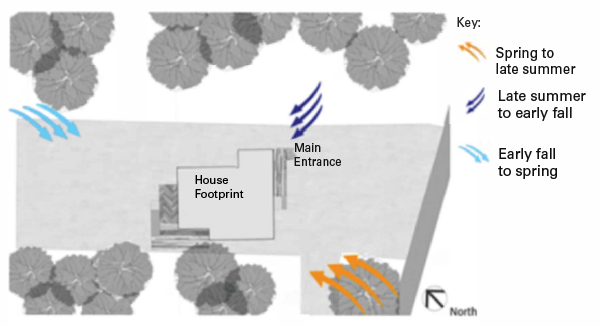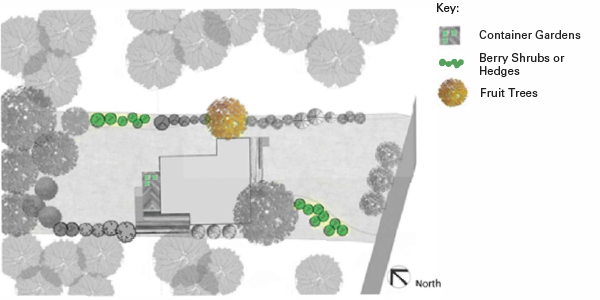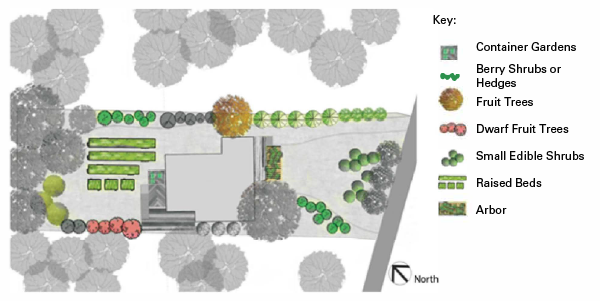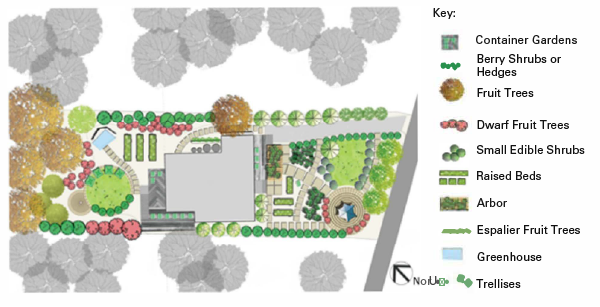Edible landscapes connect people with their food by serving up tree fruits, vegetables, berries, nuts, herbs, and edible flowers throughout the seasons. These productive gardens can offer beauty and function in the landscape, unique edible options for the table, and many other benefits.
By planting edible landscapes, gardeners can also
- enjoy more control over their food with a wide array of choices of species and varieties;
- select heritage varieties and thus promote genetic diversity in edibles;
- choose varieties based on flavor, nutrition, and color rather than shelf life, which is a higher priority in commercial production;
- choose what types of fertilizers and pesticides, if any, to use on the food they grow;
- minimize their carbon footprint by reducing the resources required to store, transport, package, and market store-bought produce;
- produce a bounty for the family and share fresh produce with others;
- improve health through exercise and better nutrition; and
- stimulate the senses with diverse colors, flavors, scents, and textures.
Incorporating edibles in the landscape is not an all-or-nothing proposition. It is possible to start small, replacing just a few ornamentals with edibles, or to use edible plants in the entire landscape. Edible plants can perform many of the same functions as ornamental species, if selected carefully. For instance, they can provide beauty and shade, serve as a windbreak or fence, or enhance home security.
This publication provides three examples of edible landscape designs, with varying degrees of edible components. Each design is based on the same 1/4-acre residential suburban plot.
Site Description
The site for the sample design has the following physical characteristics:
Sun/Shade Exposure: The main entrance of the property faces southeast (Figure 1). The existing vegetation and surrounding trees leave most of the front yard and part of the back yard open to sunshine.
Topography and Drainage: The elevation generally drops from southeast to northwest of the site. In the front yard, the elevation also drops from east to west (Figure 2).
Wind Exposure: From mid-March until August, the site has a prevailing wind from the south. During late August and early September, the prevailing wind is from the east, and from September to March it is mainly from the north (Figure 3).
Example Designs and Plant Selection
Design 1: 15% edible plants
Recommended edibles for this design (Figure 4) include small containers with vegetables (shown as green boxes), berry shrubs or hedges (shown as green circles), and a small fruit tree (shown in orange). With 15% of the plants having been replaced by edibles, the garden provides a basic supplement for the household.
Design 2: 50% edible plants
The design in Figure 5 includes the addition of dwarf fruit trees (shown as pink circles), which have replaced some of the existing trees, and small, fruiting shrubs (shown as light-green circles) planted as windbreaks along the northern property edges. Raised beds (shown as green squares and rectangles) and an arbor (shown in yellow) have been added to the site. With 50% of the plants being edible, the garden provides more plant selection options than Design 1 and ensures a more productive yield. This size supports the household food supply more efficiently and economically.
Design 3: 90% edible plants
In this design (Figure 6), nearly all the plants are edible, and the landscape is lush and diverse. More raised beds have been placed in the front yard, with a greenhouse (shown as blue rectangle) added in the back to provide produce year-round. Trellises (shown as green boxes in arc shape) and more container gardens have been added at strategic points to enhance use. The inclusion of landscape structures like arbors and trellises can create attractive gathering spaces that provide transition and strengthen the connection to the garden. Placing herb containers on a deck near the kitchen makes them convenient to manage and easily accessible for food preparation. With 90% of the plants in this design being edible, this garden has the most productive yield and contributes the most to the household food supply. The design techniques used in the garden are both functional and ornamental.
Design Ideas to Consider
- Plant dwarf evergreen trees and berry shrubs along north property edges to block cold winter wind and funnel summer breezes into the property.
- Screen trashcans from sidewalk using espalier fruit trees.
- Use deciduous vines on an arbor to allow dappled light in summer and full sunlight in winter. The arbor can also provide a semi-protected garden gathering space.
- Extend the growing season by incorporating a greenhouse. Here, you can start seeds early so that transplants are ready when soil warms.
- Plant small, hardy fruit trees such as figs in the southwest corner of the garden. A warm southern exposure can extend fruit production.
- Include raised beds for easy access.
- Group plants with high water needs together to allow consistent watering and keep from overwatering plants with lower water needs. Place edibles with high demand for water in the accessible areas of the garden.
- Plant tall vegetables on the north side of the bed and low-growing vegetables on the south side. This will prevent undesired shading.
- Locate short plants on the south side of tall structures that could block necessary sunlight.
- Replace large shade trees on the south side of the property with dwarf fruit trees, which will allow more access to sun.
- Place vegetable and herb containers and hanging baskets near the kitchen entrance for easy access and ornamentation.
- Plant fruit trees and shrubs in clusters to ease harvest.
Tips for Plant Selection
- Focus on your favorites, and don’t waste space on plants that you and your family don’t like to eat.
- To increase diversity, give higher priority to edibles that are hard to find or may be expensive to purchase.
- Select varieties known to thrive in the local climate with few insect or disease problems.
- If late frosts are common, choose varieties known for late bloom.
- Some plants must be cross-pollinated. Obtain a suitable pollinator plant, if required.
- Plan for year-round beauty and harvest. For example, strawberries ripen in early spring, blueberries in late spring, blackberries in summer, and apples in fall.
- Seek out multipurpose plants. For example, pomegranate trees have delicious fall fruits, lovely yellow fall foliage, and orange spring flowers that attract hummingbirds.
See Table 1 for suggested plants (trees, shrubs, and vines) and their seasonal attributes, including fruiting and flowering. See Table 2 for growth characteristics, including height, spread, habit, and landscape function, of recommended plants (trees, shrubs, ground covers, and vines).
|
Plant Name |
Winter | Spring | Summer | Fall | ||||||||
| Wildlife | Edible | Color | Wildlife | Edible | Color | Wildlife | Edible | Color | Wildlife | Edible | Color | |
| Trees | ||||||||||||
|
American persimmon |
bird | fruit | bees | flower | bird | fruit | fall color | |||||
|
Apple |
yes | flower | yes | fruit | ||||||||
|
Asian pear |
yes | flower | yes | fruit | ||||||||
|
Asian persimmon |
bird | fruit | yes | flower | yes | fruit | fall color | |||||
|
Black walnut |
yes | flower | yes | nut | fall color | |||||||
|
Chinese chestnut |
yes | flower | yes | yes | nut | fall color | ||||||
|
Chickasaw plum |
yes | flower | yes | fruit | ||||||||
|
Common pear |
yes | flower | yes | yes | fruit | fall color | ||||||
|
Fig |
minute flower | fruit | green to bronze fruit | |||||||||
|
Japanese plum |
yes | flower | yes | fruit | purple to red skin | |||||||
|
Nectarine |
yes | flower | yes | fruit | yellow or white flesh | |||||||
|
Pawpaw |
flower | fruit | ||||||||||
|
Peach |
yes | flower | yes | fruit | white or yellow flesh | |||||||
|
Red mulberry |
yes | flower | yes | fruit | red to black fruit | |||||||
|
Pecan |
yes | flower | yes | yes | nut | brown | ||||||
| Shrubs | ||||||||||||
|
Blueberry |
yes | flower | yes | fruit | yes | |||||||
|
Chinquapin |
yes | flower | yes | yes | nut | brown | ||||||
|
Raspberry |
yes | flower | yes | fruit | yes | |||||||
| Ground Covers | ||||||||||||
|
Strawberry |
yes | flower | yes | fruit | ||||||||
|
Watermelon |
yes | flower | fruit | |||||||||
| Vines | ||||||||||||
|
Grape |
yes | flower | yes | fruit | green to purple fruit | |||||||
| yes | flower | yes | fruit | green to brown skin | ||||||||
| Download a printable copy of this table. | ||||||||||||
| Plant Name Common Name Scientific Name |
Function |
Size |
|
|
Height (ft) |
Spread (ft) |
||
| Trees | |||
|
American persimmon |
Specimen Plant |
30–80 |
20–35 |
|
Apple |
Windbreak |
12–15 |
12–15 |
|
Asian pear |
Massing or Grouping |
30–40 |
30–40 |
|
Asian persimmon |
Specimen Plant |
20–30 |
15–25 |
|
Black walnut |
Specimen Plant |
50–75 |
50–70 |
|
Chinese chestnut |
Specimen Plant |
34–40 |
40–50 |
|
Chickasaw plum |
Massing or Grouping |
4–15 |
4–20 |
|
Common pear |
Massing or Grouping |
30–40 |
30–40 |
|
Fig |
Specimen Plant |
10–30 |
10–30 |
|
Japanese plum |
Massing or Grouping |
8–10 |
10–20 |
|
Pawpaw |
Massing or Grouping |
15–30 |
15–30 |
|
Peach |
Massing or Grouping |
15–25 |
10–15 |
|
Red mulberry |
Specimen Plant |
25–30 |
35–40 |
|
Pecan |
Specimen Plant |
70–100 |
40–75 |
| Shrubs | |||
|
Blueberry |
Hedge |
3–12 |
1–10 |
|
Chinquapin |
Hedge |
6–15 |
6–20 |
|
Raspberry |
Hedge |
3–9 |
3–9 |
| Ground Covers | |||
|
Strawberry |
Massing or Grouping |
1 |
1 |
|
Watermelon |
Massing or Grouping |
1–3 |
5–20 |
| Vines | |||
|
Grape |
Screen |
6–24 |
12–60 |
|
Screen |
15–30 |
6–10 |
|
| Download a printable copy of this table. | |||
Recommended Vegetables
| Cool Season Vegetables | Warm Season Vegetables |
|
Asparagus (Perennial) |
|
|
Bean (Lima, Pole, Snap) |
|
|
Pea, Southern |
|
|
Squash (Summer, Winter) |
|
Additional Information
Find the perfect edible plants for your yard at the North Carolina Extension Gardener Plant Toolbox. Use the left column to narrow your selection.
Publication date: Nov. 17, 2020
AG-883
N.C. Cooperative Extension prohibits discrimination and harassment regardless of age, color, disability, family and marital status, gender identity, national origin, political beliefs, race, religion, sex (including pregnancy), sexual orientation and veteran status.






